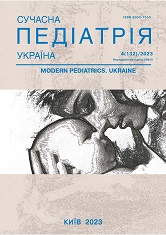Crohn’s disease in children. Clinical case
DOI:
https://doi.org/10.15574/SP.2023.132.111Keywords:
children, inflammatory bowel diseases, Crohn’s diseaseAbstract
Crohn’s disease (CD) is a chronic relapsing disease characterized by transmural granulomatous-ulcerative inflammation affecting some or all parts of the gastrointestinal tract.
Purpose - to acquaint practicing doctors with the features of the manifestations, differential diagnosis and course of CD in children.
The features of the differential diagnosis and clinical course of CD are given. The basic diagnostic value of complaints, anamnesis, clinical picture, laboratory and instrumental methods of research, histological study of a biopsy of the cecum and appendix is highlighted. Microscopic examination of the cecum biopsy revealed the presence of a corrugated surface of the mucous membrane of the large intestine with focally slightly disturbed histoarchitectonics: crypts of various sizes and shapes, some with an unevenly expanded lumen. The cellular composition of the crypts is represented by colonocytes and goblet cells with reduced mucus formation, the presence of single crypt abscesses. Own plate with foci of fibrosis, unevenly infiltrated with lymphocytes, plasma cells, segmented nuclear neutrophils, eosinophils, basal plasmacytosis is noted. The muscle plate is slightly thickened, with uneven full blood vessels, infiltrated with lymphocytes, plasma cells, segmented neutrophils, with the presence of single lymphoid follicles (“incomplete granulomas”). The morphological picture may correspond to CD (taking into account endoscopic, clinical, anamnestic and other data).
The research was carried out in accordance with the principles of the Declaration of Helsinki. Informed consent of the child’s parents was obtained for the research.
No conflict of interests was declared by the authors.
References
Bavaro DF, Ingravallo G, Signorile F et al. (2019). Splenic abscesses as a first manifestation of Crohn's disease: a case report. BMC Gastroenterol. 19 (1): 144. https://doi.org/10.1186/s12876-019-1066-1; PMid:31416435 PMCid:PMC6696686
Chen J-S, Hu F, Kugathasan S, Jorde LB, Nix D, Rutherford A et al. (2018). Targeted Gene Sequencing in Children with Crohn's Disease and Their Parents: Implications for Missing Heritability. G3: Genes. Genomes. Genetics. 8; 9: 2881-2888. https://doi.org/10.1534/g3.118.200404; PMid:30166421 PMCid:PMC6118318
Diaconescu S, Strat S, Balan GG, Anton C, Stefanescu G, Ioniuc I, Stanescu AMA. (2020). Dermatological Manifestations in Pediatric Inflammatory Bowel Disease. Medicina. 56: 425. https://doi.org/10.3390/medicina56090425; PMid:32842528 PMCid:PMC7559248
Ephraim R, Feehan J, Fraser S, Nurgali K, Apostolopoulos V. (2022). Cancer Immunotherapy: The Checkpoint between Chronic Colitis and Colorectal Cancer. Cancers. 14 (24): 6131. https://doi.org/10.3390/cancers14246131; PMid:36551617 PMCid:PMC9776998
Filimoniuk A, Blachnio-Zabielska A, Imierska M, Lebensztejn DM. Daniluk U. (2020). Sphingolipid Analysis Indicate Lactosylceramide as a Potential Biomarker of Inflammatory Bowel Disease in Children. Biomolecules. 10: 1083. https://doi.org/10.3390/biom10071083; PMid:32708181 PMCid:PMC7408557
Ghiboub M, Penny S, Verburgt CM, Boneh RS, Wine E, Cohen A et al. (2022). Metabolome Changes with Diet-Induced Remission in Pediatric Crohn's Disease. Gastroenterology. 163: 922-936. https://doi.org/10.1053/j.gastro.2022.05.050; PMid:35679949
Gordon RJ, Pappa HM, Vajapeyam S, Mulkern R, Ecklund K, Snapper SB, Gordon CM. (2022). Bone marrow adiposity in pediatric Crohn's disease. Bone. 162: 116453. https://doi.org/10.1016/j.bone.2022.116453; PMid:35667602
Kuenzig ME, Fung SG, Marderfeld L, Mak JWY, Kaplan GG. (2022). Twenty-first Century Trends in the Global Epidemiology of Pediatric-Onset Inflammatory Bowel Disease: Systematic Review. Gastroenterology. 162: 1147-1159. https://doi.org/10.1053/j.gastro.2021.12.282; PMid:34995526
Poda ОА. (2021). Crohn's disease in children: actual aspects of diagnosis and treatment according to modern international guidelines. Child's Health. 16 (1): 75-78. https://doi.org/10.22141/2224-0551.16.1.2021.226461
Ponorac S, Gošnak RD, Urlep D, Ključevšek D. (2021). Contrast-enhanced ultrasonography in the evaluation of Crohn disease activity in children: comparison with histopathology. Pediatric Radiology. 51: 410-418. https://doi.org/10.1007/s00247-020-04870-3; PMid:33411024
Repo M, Pessi J, Wirtanen E, Hiltunen P, Huhtala H, Kivelä L, Kurppa K. (2022). Frequency and clinical significance of histologic upper gastrointestinal tract findings in children with inflammatory bowel disease. Scandinavian Journal of Gastroenterology. 57 (9): 1046-1050. https://doi.org/10.1080/00365521.2022.2057197; PMid:35361047
Veauthier B, Hornecker JR. (2018). Crohn's Disease: Diagnosis and Management. American Academy of Family Physicians. 98 (11): 661-669.
Verburgt CM, Ghiboub M, Benninga MA, de Jonge WJ, Van Limbergen JE. (2021). Nutritional Therapy Strategies in Pediatric Crohn's Disease. Nutrients. 13: 212. https://doi.org/10.3390/nu13010212; PMid:33450982 PMCid:PMC7828385
Downloads
Published
Issue
Section
License
Copyright (c) 2023 Modern pediatrics. Ukraine

This work is licensed under a Creative Commons Attribution-NonCommercial 4.0 International License.
The policy of the Journal “MODERN PEDIATRICS. UKRAINE” is compatible with the vast majority of funders' of open access and self-archiving policies. The journal provides immediate open access route being convinced that everyone – not only scientists - can benefit from research results, and publishes articles exclusively under open access distribution, with a Creative Commons Attribution-Noncommercial 4.0 international license (СС BY-NC).
Authors transfer the copyright to the Journal “MODERN PEDIATRICS. UKRAINE” when the manuscript is accepted for publication. Authors declare that this manuscript has not been published nor is under simultaneous consideration for publication elsewhere. After publication, the articles become freely available on-line to the public.
Readers have the right to use, distribute, and reproduce articles in any medium, provided the articles and the journal are properly cited.
The use of published materials for commercial purposes is strongly prohibited.

